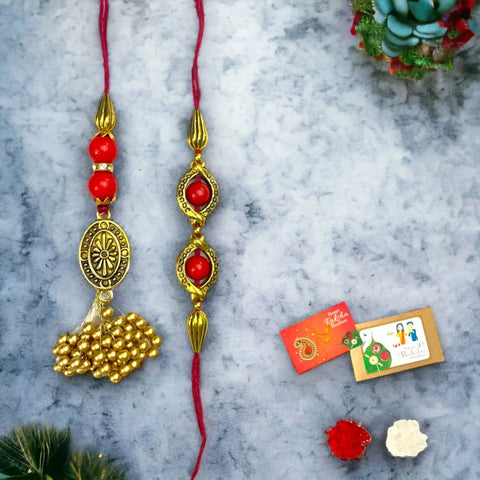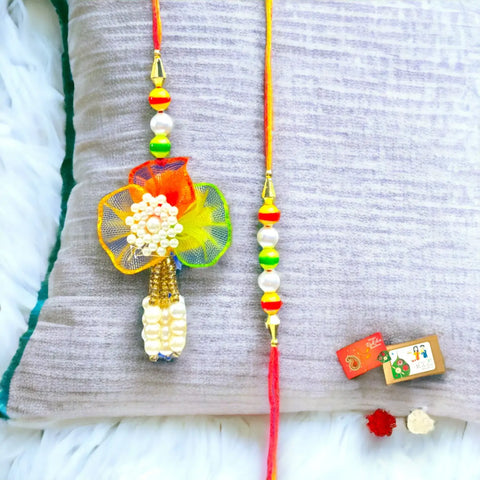Blog Introduction:
Raksha Bandhan is a festival that celebrates the bond of love between siblings. It is a time when brothers promise to protect their sisters, and sisters pray for their brother's well-being. One of the essential elements of this festival is the rakhi, which is a sacred thread tied on a brother's wrist to symbolize their bond. But did you know that sisters-in-law also have a significant role to play in Raksha Bandhan? Yes, they tie a special kind of rakhi called the lumba rakhi on their brother-in-law's wrist. In this blog post, we will explore the history, significance, and types of lumba rakhi, along with tips on how to wear it with different attire. So, let's get started.


History of Lumba Rakhi:
The lumba rakhi is a traditional Indian adornment that originated in Marwari culture and has significant importance in Rajasthani society. It is worn exclusively by sisters-in-law, and the word "lumba" means bangle in Hindi. The lumba rakhi is usually longer than the regular rakhi and has tassels or danglers at the end. This unique design signifies the long-lasting relationship between sisters-in-law and their brother-in-law.
Over the years, lumba rakhi designs have evolved, and now you can find them in various styles and materials. Traditional lumba rakhi had embroidery and mirrorwork, but now you can find ones with sequins, beads, and other embellishments. The influence of modern fashion has also led to fusion designs that blend traditional and contemporary styles, making them more versatile and suitable for different occasions.
Different Types of Lumba Rakhi:
There are several types of lumba rakhi, each with its unique design, symbolism, and significance. For instance, danglers have small bells, beads, or charms hanging on them to make a jingling sound, indicating the arrival of a sister-in-law. Mirrorwork lumba rakhi features intricate patterns of tiny mirrors, signifying the reflection of family and cultural heritage. Embroidered lumba rakhi has colorful threadwork that represents the vibrancy and joy of festival celebrations. Each design has its unique beauty and meaning, making lumba rakhi a significant part of Raksha Bandhan.
How to Wear Lumba Rakhi:
Lumba rakhi is traditionally worn on the bangle of a sister-in-law. However, you can also wear it on the wrist or attach it to a saree or dupatta for a more dramatic effect. When wearing lumba rakhi with traditional Indian attire, opt for colors that complement or contrast with your outfit. You can either coordinate the colors or mix and match them to create a unique look. If you're pairing lumba rakhi with Western attire, keep simplicity in mind and avoid too many accessories that can overpower the rakhi's beauty.


Choosing the right size and style of the lumba rakhi is crucial, as it should fit well and be comfortable to wear. You can find them in various sizes, and you should select one that suits your wrist size and the thickness of the bangle if you plan to wear it that way.
Importance of Lumba Rakhi in Modern Times:
In modern times, the role of sisters-in-law has changed, and they have become an integral part of families. Lumba rakhi celebrates this bond of love between sisters and sisters-in-law, reflecting the importance of inclusivity and equality in society. It also promotes traditional handicrafts and cultural heritage, helping to preserve India's rich cultural diversity. So, this Raksha Bandhan, let us celebrate this bond of love with lumba rakhi, and pay homage to the divine feminine's power and beauty.
Conclusion:
Raksha Bandhan is a time of celebration, love, and cherished relations. The lumba rakhi is an essential part of this celebration, and its significance reflects the evolving role of sisters and sisters-in-law in society. From its roots in Marwari culture to its current fusion styles, lumba rakhi has come a long way in preserving India's cultural heritage. So, let us embrace this tradition and celebrate the bond of love with our siblings and sisters-in-law. Happy Raksha Bandhan!













